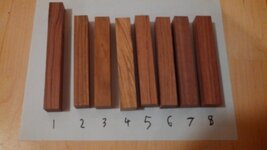You are using an out of date browser. It may not display this or other websites correctly.
You should upgrade or use an alternative browser.
You should upgrade or use an alternative browser.
mystery wood #9... last one
- Thread starter NotURMailman
- Start date
Signed-In Members Don't See This Ad
Signed-In Members Don't See This Ad
nativewooder
Member
You know, not meaning to be critical, but you could buy your pen blanks from IAP vendors or from members, who know the name of every piece of wood they sell!!! Except me! I've bought so much wood that the ink wore off the wood! :biggrin:
:biggrin:
NotURMailman
Member
I usually do, but the price was hard to beat. 100 blanks for less than $50 including shipping. And if I mess them up (since I'm new at this) I won't care! I didn't think any one would be bothered by me asking for some help when I wasn't quite sure. My apologies.
OOPS
Member
Most of us are not bothered by you asking. Feel free to post away.
NotURMailman
Member
This is one of the last two pictures that I am still not sure of. Could it be more Red Oak?
With #4 maybe being regular Oak?
With #4 maybe being regular Oak?
Last edited:
monophoto
Member
Don't think it's oak.
Is the grain open or closed? It's hard to tell from the picture - it almost looks like cherry, but I would need to touch it to know for sure.
Is the grain open or closed? It's hard to tell from the picture - it almost looks like cherry, but I would need to touch it to know for sure.
NotURMailman
Member
All buy #4 "feel" pretty smooth if that's what you're asking.
76winger
Member
I'm looking at a small picture on my cellphone, but it sort of looks like tulipwood
OOPS
Member
Based upon what I have seen and been told, there are two types of Tulipwood. Blank #4 certainly looks like Brazilian Tulipwood, which is generally a light colored wood with bright reddish grain lines running through it. The other type of Tulipwood grows in the eastern U.S. It can either be light or dark, but is more "creamy" in texture (if that's an appropriate description.) Because the rest of the group has the well defined reddish grain lines, I would say that its all Brazilian Tulipwood. Personally I have not seen any that is this dark before, so perhaps another with more experience can chime in. One thing I can say is that Tulipwood makes great pens, IMHO.
plantman
Member
svanzile
Member
This looks like walnut heartwood.
jcm71
Member
Brazilian Tulipwood???

